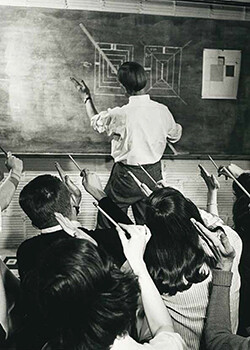June 18–July 14, 2015
Palais des Beaux-arts Paris
13 quai Malaquais
75012 Paris
Participating artists:
Rita Ackermann, Josef Albers, John Baldessari, Joseph Beuys, Thierry Boutonnier, Travis Boyer, Kasper Bosmans, Kim Bradford, Atelier Bruguera, Zoé Capdevielle, Grégory Castéra, Paul Créange, Édouard Cuyer, Bady Dalloul, Alexandre Damerval, Nicolas Darrot, Mark Dion, Guillaume-Benjamin Duchenne, Albrecht Dürer, Robert Filliou, Mara Fortunatović, Mats Gustau, Isabella Hin, Thomas Hirschhorn and students, Jean-Antoine Houdon, Jean-Auguste- Dominique Ingres, Max Jefcut, Pablo Jomaron, Yaël Kreplak, Jean-Gaspard Lavater, Franck Leibovici, Christophe Lemaitre (Avec François Lancien-Guilberteau, Aurélien Mole, Sarah Tritz), Naomi Lulendo, Diogo Maia, Benoît Maire, Robin Jiro Margerin, Léonard Martin, Michelangelo, Olivier Mosset, Nils Norman, Yoshua Okón, Élisabeth Péleraux, G.T. Pellizzi, Philomène Pirecki, Polydore, Morgane Porcheron, Pablo Prieto, Eileen Quinlan, Marthe Ramm Fortun, Paul Richer, Martha Rosler, Tanguy Roussel, Clara Saracho de Almeida, Camille Sauer, Pierre Seiter, The V-Girls (Martha Baer, Jessica Chalmers, Erin Cramer, Andrea Fraser, Marianne Weems), Théophile Stern, Mladen Stilinović, Christelle Tea, Cheyney Thompson, Victor Vaysse, Ana Vega, Marta Wengorovius, Adolphe Zimmern, Mathieu Zurcher.
Director of the Beaux-arts de Paris: Nicolas Bourriaud
Curated by: Sarina Basta, Gulbenkian curator, associated with les Beaux-Arts de Parisin 2015
The exhibition Transmission: recreation and repetition presents the work of students and graduates of the Beaux-Arts of Paris and guest artists who place pedagogy at the center of their practice, or who use representation of pedagogy as form. The exhibition includes John Baldessari, Joseph Beuys, and Martha Rosler among many others.
A section of the exhibition is dedicated to Josef Albers, and a selection of works created with his students throughout various moments of his career at the Bauhaus, Black Mountain and Yale. Saisies du reel is yet another section of the exhibition, a selection of pedagogical objects of the collection of the Beaux-Arts from the 16th century until today.
The exhibition reveals positions that artists can occupy, thought, processes and key moments when pedagogy becomes form. At a moment when the immaterial aspects of art and patrimony are being accepted as an important part of our cultural legacy, rituals of gathering, exchange and transmission of knowledge are today under scrutiny.
Within an art school such as the Beaux-arts, the first central question would be: what actually occurs in the process of learning and teaching? Transmission, recreation and repetition examines some of the immaterial processes and actions that take place around objects, the type of discourses and forms transmitting and co-producing knowledge. The exhibition also highlights a selection of works and pedagogical objects by Michelangelo and Jean-Antoine Houdon, and work by renowned students and teachers of the Beaux-arts such as Jean-Dominique Ingres. Within the tradition of the academy (re)creation is originally thought as learning through copying, interpreting and emulating the masters, while it is through repetition that the gesture of mastery itself is obtained. The premise of the exhibition examines how these processes operate today.
The exhibition also examines the academic institution as a site of power and authority, yielding pockets of autonomy as described by Barthes in “Leçon,” a speech given at the College de France in 1977. Within the art school the very representation of the artist is transmitted. Politics of representation are examined in the exhibition through the work of the V-Girls, Martha Baer, Jessica Chalmers, Erin Cramer, Andrea Fraser, and Marianne Weems. The bien fait, mal fait, pas fait (well-made, poorly made, not made) as enounced by Robert Filliou, also surfaces, as does the very subjectivity of the students in the exhibition.
Transmission: recreation and repetition involves students of the school of the Beaux-arts, workshops and a series of guests who have had pedagogy as practice, or whose artistic processes adopt the language and aesthetics of learning and teaching. Play and the Pensée Sauvage are highlighted as well as structures of thoughts and interaction.
The exhibition was organized in collaboration with Philippe Comar, professor of morphology at the Beaux-arts. A 210-page catalogue was published (in French) at the occasion of the exhibition, with original texts by and on the artists.
On the Beaux-Arts:
Heir to the Royal Academies of painting and sculpture founded under the Ancien Régime, located in the heart of Saint-Germain des Prés in an exceptional architectural ensemble, the Beaux-Arts de Paris is a state public institution overseen by the Ministry of Culture and Communication. The curriculum is based on studio work, diversity in practices and international exchange. The school delivers a first-cycle diploma after three years of study, and the diplôme national supérieur d’arts plastiques (DNSAP) at the end of the fifth year, equivalent to a master’s degree. A post-graduate research cycle has completed this curriculum since the first term of 2012. It places a strong emphasis on new technologies as well as on the transmission of more traditional techniques and the study of theory.
The Beaux-Arts de Paris represents over 500 students, 100 professors, artist-teachers and technicians, over 80 international exchange agreements with art schools all over the world, a media library offering 45,000 works and a collection of over 450,000 artworks, including the second largest collection of drawings after the Louvre’s. For more information on the Beaux-Arts please click here.


